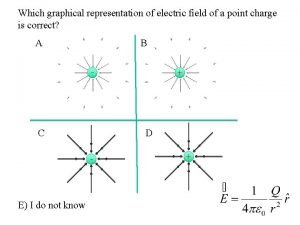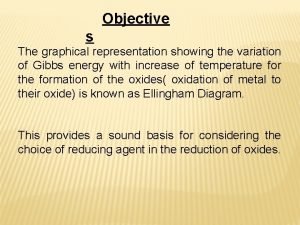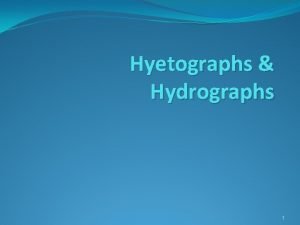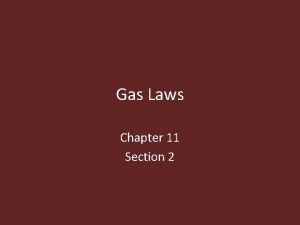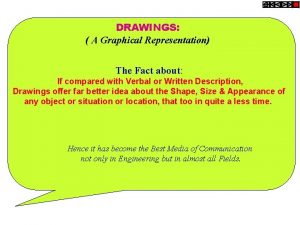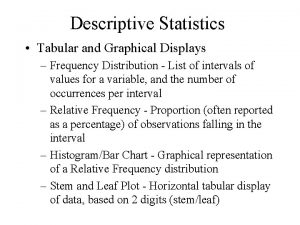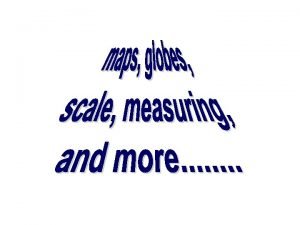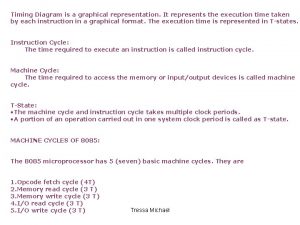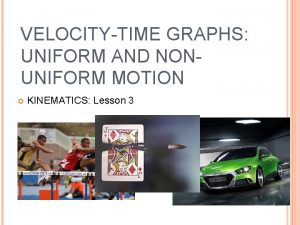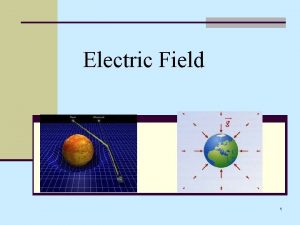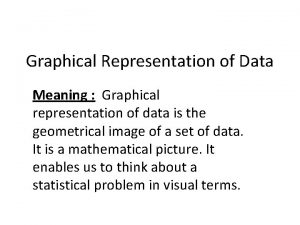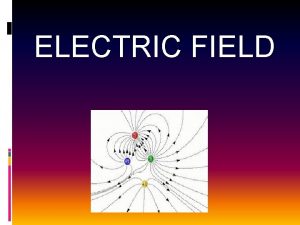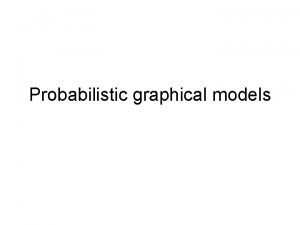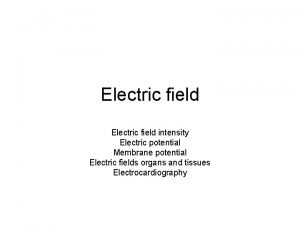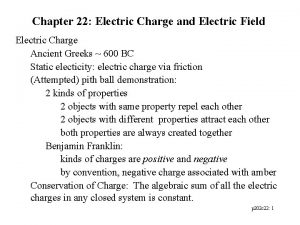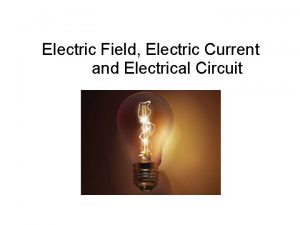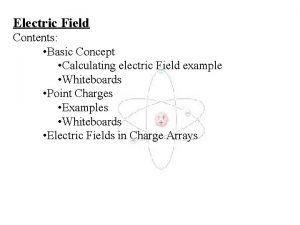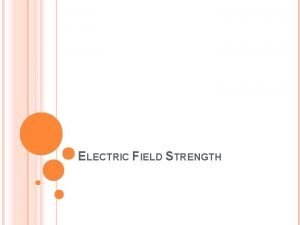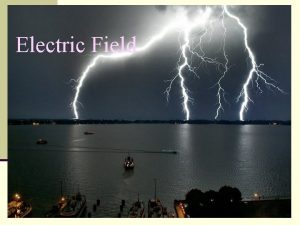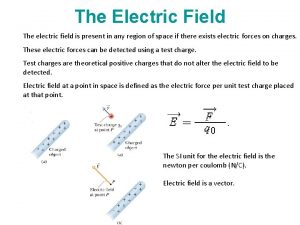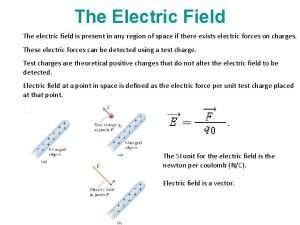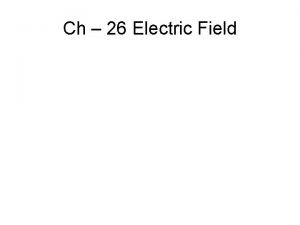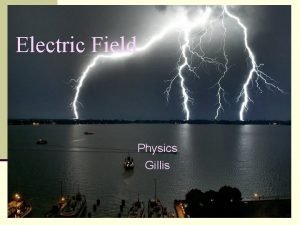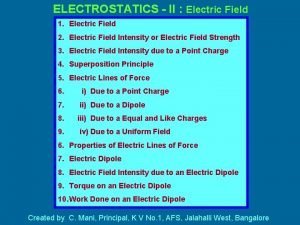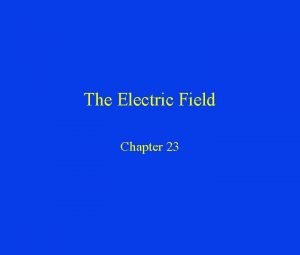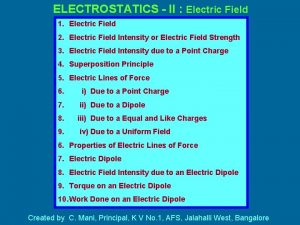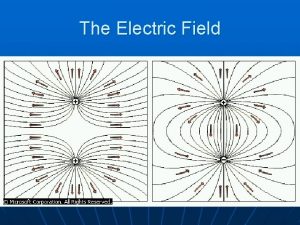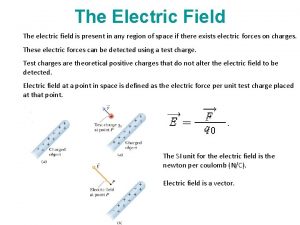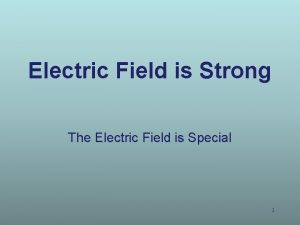Which graphical representation of electric field of a





















![Electric Field Electric field has units of Newton per Coulomb: [N/C] Electric Field Electric field has units of Newton per Coulomb: [N/C]](https://slidetodoc.com/presentation_image_h/ca25caba01bb3299db9b0c8254a5e25a/image-22.jpg)



- Slides: 25

Which graphical representation of electric field of a point charge is correct? A B _ C D _ E) I do not know + +

A _ What if the magnitude of electric field exactly at the position of a point charge? Point charge does not exert field on itself!

The Superposition Principle The net electric field at a location in space is a vector sum of the individual electric fields contributed by all charged particles located elsewhere. The electric field contributed by a charged particle is unaffected by the presence of other charged particles.

The Superposition Principle If many more point charges are present (qi) we go for i and eventually for integral ! i

System consists of two point charges (+4) and (+1) +4 +1 How many points exist in space where E-field is equal zero? A) B) C) D) E) None One Two Infinite number I don’t know

E-field in the middle of uniformly positively charge ring is represented by y What is about any other point inside the ring? x A) B) C) D) Red arrow Blue arrow Zero I do not know

The E of a Uniformly Charged Sphere Can calculate using principle of superposition: for r>R (outside) for r<R (inside)

The Superposition Principle The electric field of a dipole: Electric dipole: Two equally but oppositely charged point-like objects s -q +q Example of electric dipole: HCl molecule What is the E field far from the dipole (r>s)?

Dipoles are ubiquitous 1. Atom will become dipole when it experiences electric field: 2. Some molecules exist in the form of permanent dipoles: HCl molecule

In Protein the carbonyl groups of polypeptides have substantial dipole moments and their electrostatic interactions make an important energetic contribution to the stability of an a-helix O C + D=3. 7 Debye

Calculating Electric Field Choice of the origin y s -q +q x z Choice of origin: use symmetry

1. E along the x-axis

Approximation: Far from the Dipole if r>>s, then While the electric field of a point charge is proportional to 1/r 2, the electric field created by several charges may have a different distance dependence.

2. E along the y-axis

2. E along the y-axis if r>>s, then at <0, r, 0>

3. E along the z-axis at <r, 0, 0> at <0, r, 0> or <0, 0, r> Due to the symmetry E along the z-axis must be the same as E along the y-axis!

Other Locations

The Electric Field Point Charge: + Dipole: for r>>s : y s -q z - at <r, 0, 0> at <0, r, 0> +q x at <0, 0, r>

System consists of two point charges (+1) and (-1) +1 -1 How many points exist in space where E-field is equal zero? A) B) C) D) E) None One Two Infinite number I don’t know

Dipole in a Uniform Field Forces on +q and –q have the same magnitude but opposite direction It would experience a torque about its center of mass. What is the equilibrium position? Electric dipole can be used to measure the direction of electric field.

Dipole Moment x: r>>s y, z: The electric field of a dipole is proportional to the Dipole moment: p = qs , direction from –q to +q Dipole moment is a vector pointing from negative to positive charge
![Electric Field Electric field has units of Newton per Coulomb NC Electric Field Electric field has units of Newton per Coulomb: [N/C]](https://slidetodoc.com/presentation_image_h/ca25caba01bb3299db9b0c8254a5e25a/image-22.jpg)
Electric Field Electric field has units of Newton per Coulomb: [N/C]

A Fundamental Rationale • Convenience: know E at some location – know the electric force on any charge: • Can describe the electric properties of matter in terms of electric field – independent of how this field was produced. Example: if E>3 106 N/C air becomes conductor • Retardation Nothing can move faster than light c c = 300, 000 km/s = 30 cm/ns Coulomb’s law is not completely correct – it does not contain time t nor speed of light c. v<<c !!!

Example Problem y E=? A dipole is located at the origin, and is composed of particles with charges e and –e, separated by a distance 2 10 -10 m along the xaxis. Calculate the magnitude of the E field at <0, 2 10 -8, 0> m. Since r>>s: 200Å 2Å x Using exact solution:

Interaction of a Point Charge and a Dipole • Direction makes sense? - negative end of dipole is closer, so its net contribution is larger • What is the force exerted on the dipole by the point charge? - Newton’s third law: equal but opposite sign
 Provides a graphical representation of an electric field
Provides a graphical representation of an electric field Formula of electric field
Formula of electric field Potential in uniform electric field
Potential in uniform electric field Electrostatic potential energy definition
Electrostatic potential energy definition Electric potential from electric field
Electric potential from electric field Chapter 21 electric charge and electric field
Chapter 21 electric charge and electric field Chapter 21 electric charge and electric field
Chapter 21 electric charge and electric field Units for coulombs
Units for coulombs Units of a charge
Units of a charge Gauss law of magnetism
Gauss law of magnetism Q factor of capacitor
Q factor of capacitor Magnetic field
Magnetic field Salient features of ellingham diagram
Salient features of ellingham diagram What is a hyetograph
What is a hyetograph Boyle's law graphical representation
Boyle's law graphical representation Is a graphical representation of an algorithm
Is a graphical representation of an algorithm A histogram is a graphical representation of
A histogram is a graphical representation of A graphical representation of data.
A graphical representation of data. Frequency of damped oscillation
Frequency of damped oscillation Graphical representation of shm
Graphical representation of shm Mass haul diagram
Mass haul diagram Third angle projection method
Third angle projection method Tabular and graphical representation of data
Tabular and graphical representation of data Is a graphical representation of the ground drawn to scale.
Is a graphical representation of the ground drawn to scale. Mov a m timing diagram
Mov a m timing diagram Uniform speed graph
Uniform speed graph
